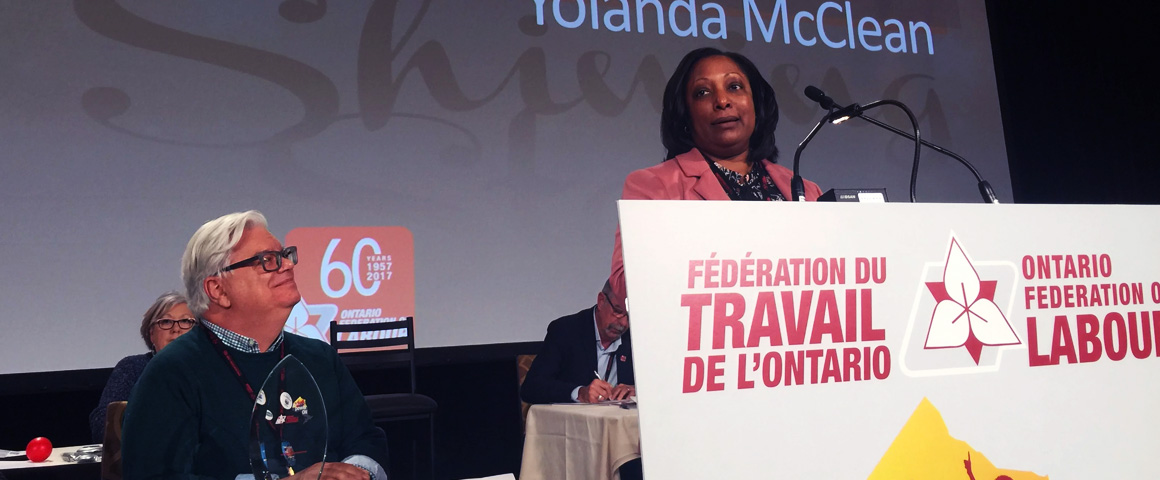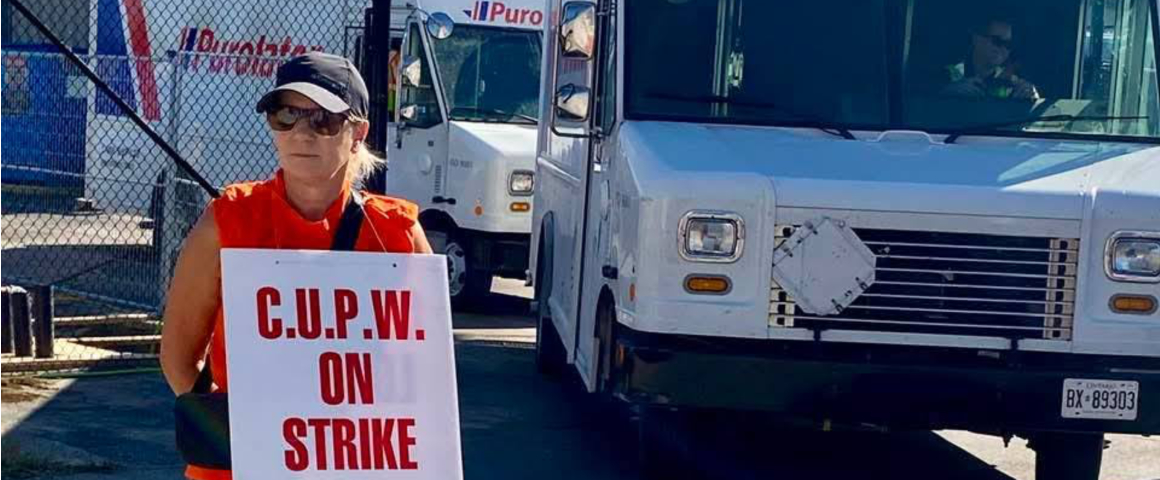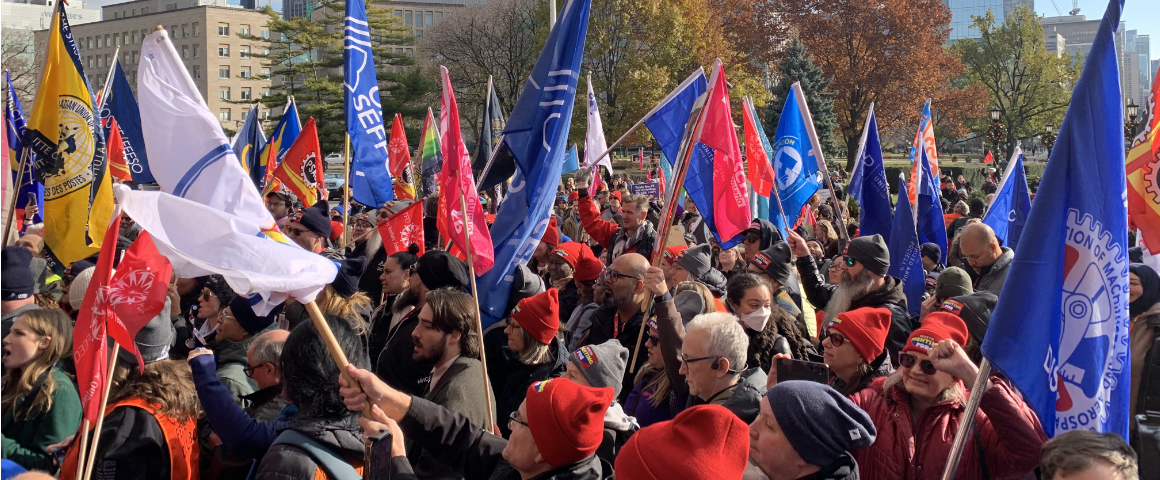PV Ontario Bureau
Hundreds of union delegates met in Toronto from November 20-24th to discuss policy resolutions and adopt a plan of work, at the biennial convention of the Ontario Federation of Labour. This was the first convention since the newly elected team of Chris Buckley, Patti Coates and Ahmed Gaied replaced Sid Ryan, Irwin Nanda and Nancy Hutchinson two years ago. This leadership projected a united image claiming that many of the crises plaguing the OFL over the previous four years have been resolved or dealt with.
With the return of two large affiliates and the sale of the OFL building, the treasurers’ report was praised as being miraculous and that a million dollars in debt had been retired. Not mentioned was that the financial crisis had been caused by a few large affiliates withholding their dues per capita, in protest of the previous leadership. The return of OPSEU and the SEIU had largely been expected this past year, since they made it clear they would return if Sid Ryan were replaced as president. However, it is unclear how much of their withheld dues these two unions paid upon re-affiliating. It is likely that they only paid a token amount, similar to what the CAW paid upon their return from an extended absence in the last decade. The labour movement needs to find a way to prevent an affiliate from withdrawing its funds and financially strangling its provincial labour central when it disagrees with its decisions.
The OFL is Canada’s largest provincial labour federation, representing 54 unions and one million workers. This convention celebrated its 60th anniversary with a general sense of comradery and unity. Much of this celebratory mood was focused on Ontario’s fight for $15 and Fairness, which saw labour and community allies work tirelessly to improve labour laws and raise the provincial minimum wage. During the convention, legislation passed that increases the minimum wage to $14 on January 1, 2018 and to $15 by January 2019. The new law also includes a host of other improvements in sick leave, equal pay, vacation and emergency personal leave for all workers.
Buckley’s “FedForward” team was handily re-elected. Hamilton activist Barry Conway challenged for the presidency, on a platform of fighting resurgent fascism and stopping raiding, but his campaign had only begun during the convention, so it was very small. Still, Conway was supported by 18% of the delegates, indicating a notable protest vote against Buckley’s leadership.
The proposed Action Plan was presented for discussion on the first day of the convention, a significant improvement over the past two decades. The plan included 118 items, ranging from statements on various areas of struggle, ongoing work for improved labour laws, fighting for decent green jobs, and a commitment to organize new communities and sections of the working class. Overall, the action plan rededicates itself to achieving equity and diversity in the OFL’s approach to political action. In promoting peace and equality, the plan asks that workers not be divided but instead stand firm against white supremacy, islamophobia, anti-Semitism, anti-black racism and racism in all of its forms.
The convention adopted a motion, advanced by the Action Caucus and submitted by a number of affiliates, declaring housing a human right and demanding that the provincial government: immediately introduce a comprehensive social housing program and delivers it according to need; develop and implement an emergency plan to build new, publicly owned social housing; legislate real rent controls and roll backs for all renters; legislate a ban on evictions and utility cut-off due to involuntary unemployment, including strikes, lockouts and layoffs.
The resolution also calls for the OFL to launch a campaign with labour councils and affiliates to mobilize workers to demand a provincial housing program.
As with many of the action plan items, it remains to be seen which priorities the executive council and executive board set over the next two years. A number of commitments made in the 2015 plan remain unfulfilled. Furthermore, the Buckley leadership deliberately abandoned the Ontario Common Front, an effort to bring together labour and community allies in a structured movement, which was the main conduit for achieving many of the key elements of the action plan.
Ironically, the new plan proposes that the success of the Ontario Common Front be expanded in building allies, and notes that “together, community and labour hold tremendous potential for creating transformative change”.
In the midst of this cautious and, at times, orchestrated sense of unity, the issue of the OFL’s election strategy and labour’s relationship to the NDP emerged as a sharply divisive flashpoint.
The most controversial amendment to the action plan focused on the goal of achieving “one million votes for the NDP”. With specific timelines and commitments, the amendment calls on all affiliates to collaborate uncritically and unconditionally with the Ontario NDP, to train voter organizers in key ridings, and to mobilize a minimum of 150 organizers from union activists, including young workers and retirees. No other section of the action plan contains such detailed commitments for either the OFL leadership or the affiliates.
The election amendment was sponsored by unions with longstanding links to the NDP, and was opposed by unions not aligned with any specific political party. Its introduction was set up by speeches from Ontario NDP leader Andrea Horwath, federal NDP leader Jagmeet Singh, and from long-time NDP leader Stephen Lewis, who curiously spoke about strategic voting during his panel on human rights.
The debate on the floor revealed some of the underlying political divisions within the OFL and the labour movement as a whole. Some delegates indicated they favour a “strategic voting” approach which allows their members to vote for that candidate best positioned to block or defeat a Tory candidate. Others argued that the NDP is the “only party that supports the labour movement”. Many progressives argued that this insertion was divisive and would in the long run, weaken the unity of the OFL by making uncritical and unconditional support for the NDP a binding tactic in the upcoming provincial election. Examples were given where the NDP did not embrace the labour movement’s positions and where their campaign platforms lagged behind those of other parties.
In the end, the action plan was divided into two parts, with the election tactic voted on separately. The bulk of the plan passed unanimously, but with diminished enthusiasm. The election strategy passed with a 70-30 vote, and the feelings of division and bitterness extended throughout the room.
The challenge to the trade union movement, in the aftermath of this convention, will be to recover the sense of unity that filled the room at the start. The best way to do this is for the OFL to engage and mobilize all affiliates around those elements of the action plan that were unanimous – including fighting racism and white supremacy, organizing the unemployed and unorganized, and pressing for strong action on the housing crisis.
Without question, for this to happen the labour movement needs a much stronger and structured Left, who can speak to the necessity of projecting a comprehensive set of independent demands for workers. Such activity would force political parties to answer to working class issues, much more effectively than by giving “carte blanche” to the NDP or any other political party.




